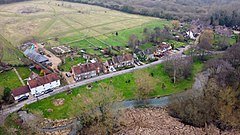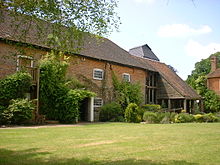
The Royal County of Berkshire, commonly known as simply Berkshire, is a ceremonial county in South East England. It is bordered by Oxfordshire to the north, Buckinghamshire to the north-east, Greater London to the east, Surrey to the south-east, Hampshire to the south, and Wiltshire to the west. Reading is the largest settlement and the county town.

Newbury is a market town in West Berkshire, England, in the valley of the River Kennet. It is 26 miles (42 km) south of Oxford, 25 miles (40 km) north of Winchester, 27 miles (43 km) southeast of Swindon and 20 miles (32 km) west of Reading. It is also where West Berkshire Council is headquartered.
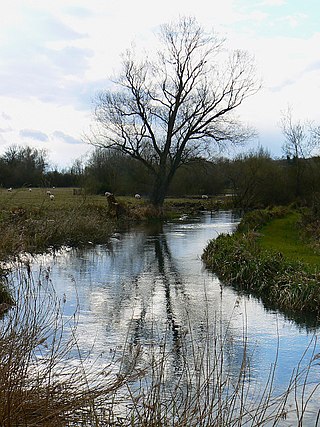
The Kennet is a tributary of the River Thames in Southern England. Most of the river is straddled by the North Wessex Downs AONB. The lower reaches have been made navigable as the Kennet Navigation, which – together with the Avon Navigation, the Kennet and Avon Canal and the Thames – links the cities of Bristol and London.

Speen is a village and civil parish in West Berkshire, England. Centred 2 miles (3 km) north west of the largest town in the district, Newbury, Speen has clustered settlements, the largest of which is Speen village, which is contiguous with Newbury, and the others, buffered from the town by the A34 road, are Bagnor, Stockcross, Woodspeen and Marsh Benham. Its other land is an approximately even mixture of woodland and agricultural fields including hay meadows for livestock feed and pasture. The area varies greatly in elevation, having the Reading to Taunton Line alongside the north bank of the River Kennet as its southern boundary and both banks of the River Lambourn in its north with elevated ground in between. Benham Park in the south-west of the area is a listed landscape garden and house.

The River Lambourn is a chalk stream in the English county of Berkshire. It rises in the Berkshire Downs near its namesake village of Lambourn and is a tributary of the River Kennet, which is itself a tributary of the River Thames.

Lambourn is a village and civil parish in Berkshire, England. It lies just north of the M4 Motorway between Swindon and Newbury, and borders Wiltshire to the west and Oxfordshire to the north. After Newmarket it is the largest centre of racehorse training in England, and is home to a rehabilitation centre for injured jockeys, an equine hospital, and several leading jockeys and trainers. To the north of the village are the prehistoric Seven Barrows and the nearby long barrow. In 2004 the Crow Down Hoard was found close to the village.
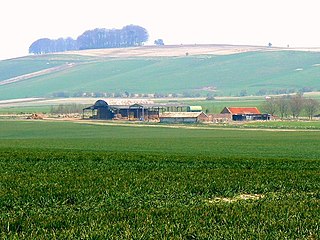
Winterbourne Bassett is a small village and civil parish in Wiltshire, England, about 6 miles (10 km) southwest of Swindon and 7 miles (11 km) northwest of Marlborough.
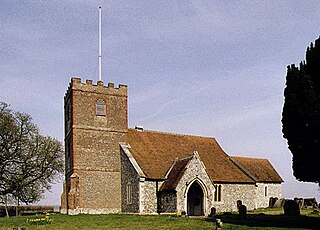
Winterbourne is a village and civil parish in the Berkshire Downs about 3 miles (5 km) north of Newbury in West Berkshire.

The Second Battle of Newbury was a battle of the First English Civil War fought on 27 October 1644, in Speen, adjoining Newbury in Berkshire. The battle was fought close to the site of the First Battle of Newbury, which took place in late September the previous year.

Leckhampstead is a village and civil parish in West Berkshire, England in the North Wessex Downs. A road and boundary stone in Leckhampstead, the Hangman's Stone and Hangman's Stone Lane, are named after a tale of a man who roped and carried a stolen sheep from a farm in Leckhampstead around his neck, but which strangled him after he stopped and slept. After a long hiatus the area returned to full village status in 1864. Its hamlet of Hill Green has six listed buildings and the amenities of the village include a public house, church and village hall. The associated hamlet of Leckhampstead Thicket has a high proportion of its buildings that are thatched cottages and has a Primitive Methodist chapel, dated 1874.

Boxford is a village and civil parish in the unitary authority of West Berkshire, England. The village is on the east bank of the River Lambourn, about 4 miles (6.4 km) northwest of Newbury but south of the M4 motorway. The hamlet of Westbrook is on the opposite bank of the Berkshire Downs tributary.
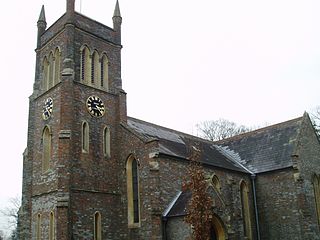
Stockcross is a village in Berkshire, England. The village lies to the west of Newbury in the civil parish of Speen and the district of West Berkshire. Close to the cross-road in the middle of the village were the stocks hence the name Stock-Cross, which were removed in the early 1980s.

Weston is a village in the civil parish of Welford in the English county of Berkshire.

Speenhamland is an area within modern Newbury, Berkshire.

Eastbury is a village in the valley of the River Lambourn in the English county of Berkshire. The village is situated on the old river level road from Newbury to Lambourn, and is 1.5 miles (2.4 km) east of Lambourn and 1 mile (1.6 km) west of East Garston. The village is situated in the civil parish of Lambourn, which is within the unitary authority of West Berkshire.
Honey Bottom is a hamlet in the civil parish of Shaw-cum-Donnington in the English county of Berkshire.
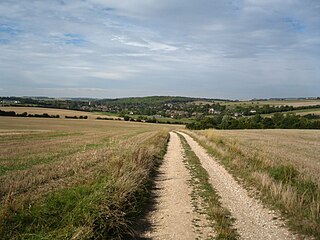
Bockhampton is an abandoned village in Berkshire that was enclosed in the late 18th century. Situated on the River Lambourn southeast and downstream of Lambourn it was also known as Lower Lambourn, as opposed to Upper Lambourn which is upstream. Bockhampton was mentioned in the Domesday Book of 1086 as "Bochentone: Ralph the earl's son; Odo and Edward, king's thanes. Mill." who held the land in return for keeping the King's harriers. Bockhampton Manor House was built in the 16th century by Thomas Blagrave and absorbed the three old manors of East Bockhampton, West Bockhampton and Hoppeshortland. The village was uprooted and the land enclosed in 1776 thanks to the 1773 Inclosure Act, as sheep farming proved to be more profitable than tillage. There is a road sign for Bockhampton on the Newbury Road pointing down Bockhampton Road towards the old site of the village in the sheep pasture next to the electricity substation.

Rack Marsh is a 4-hectare (9.9-acre) nature reserve in Bagnor, on the north-western outskirts of Newbury in Berkshire. It is managed by the Berkshire, Buckinghamshire and Oxfordshire Wildlife Trust. It is part of Kennet and Lambourn Floodplain, which is a Biological Site of Special Scientific Interest, and a Nature Conservation Review site. It is also part of the Kennet and Lambourn Floodplain Special Area of Conservation.
